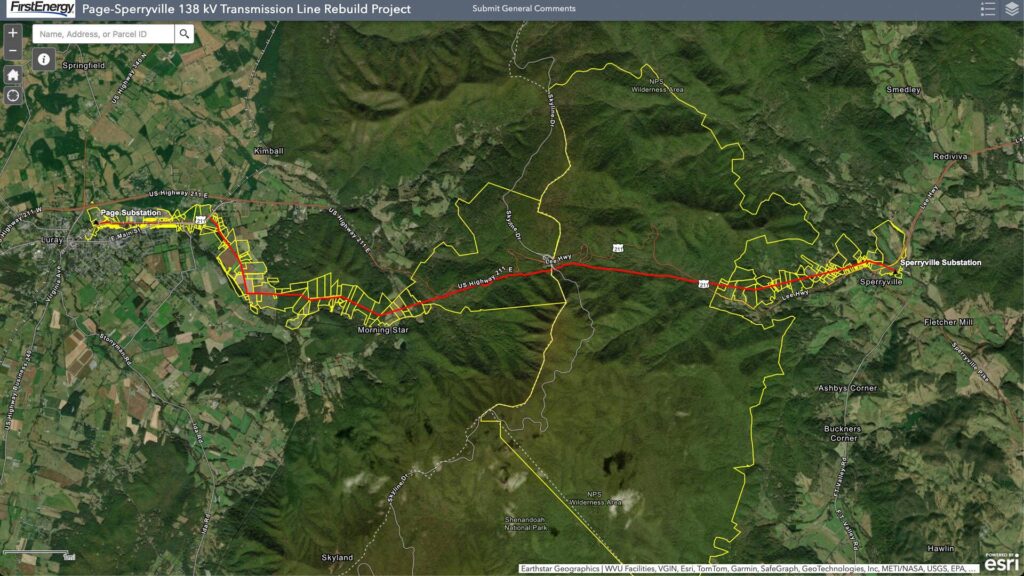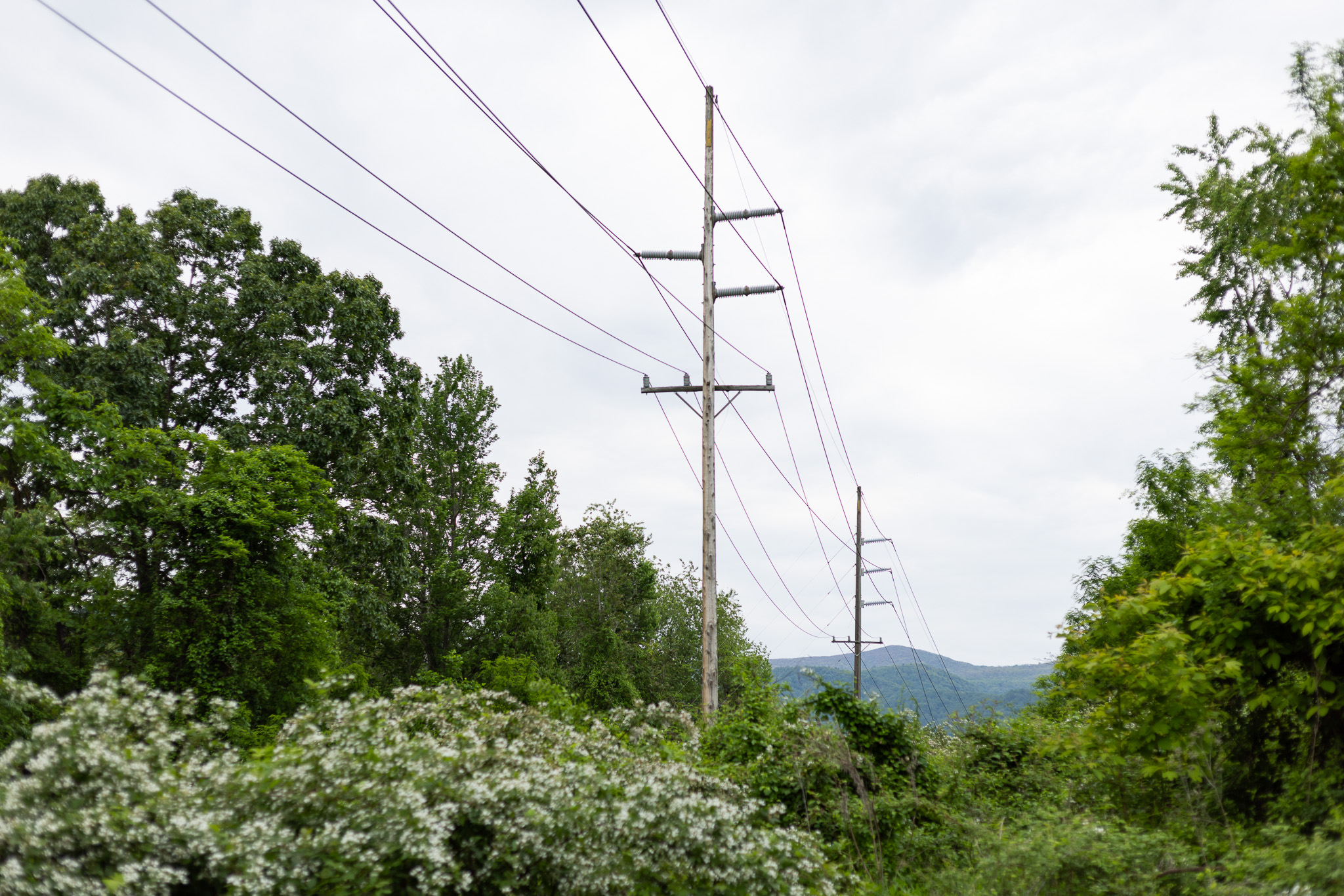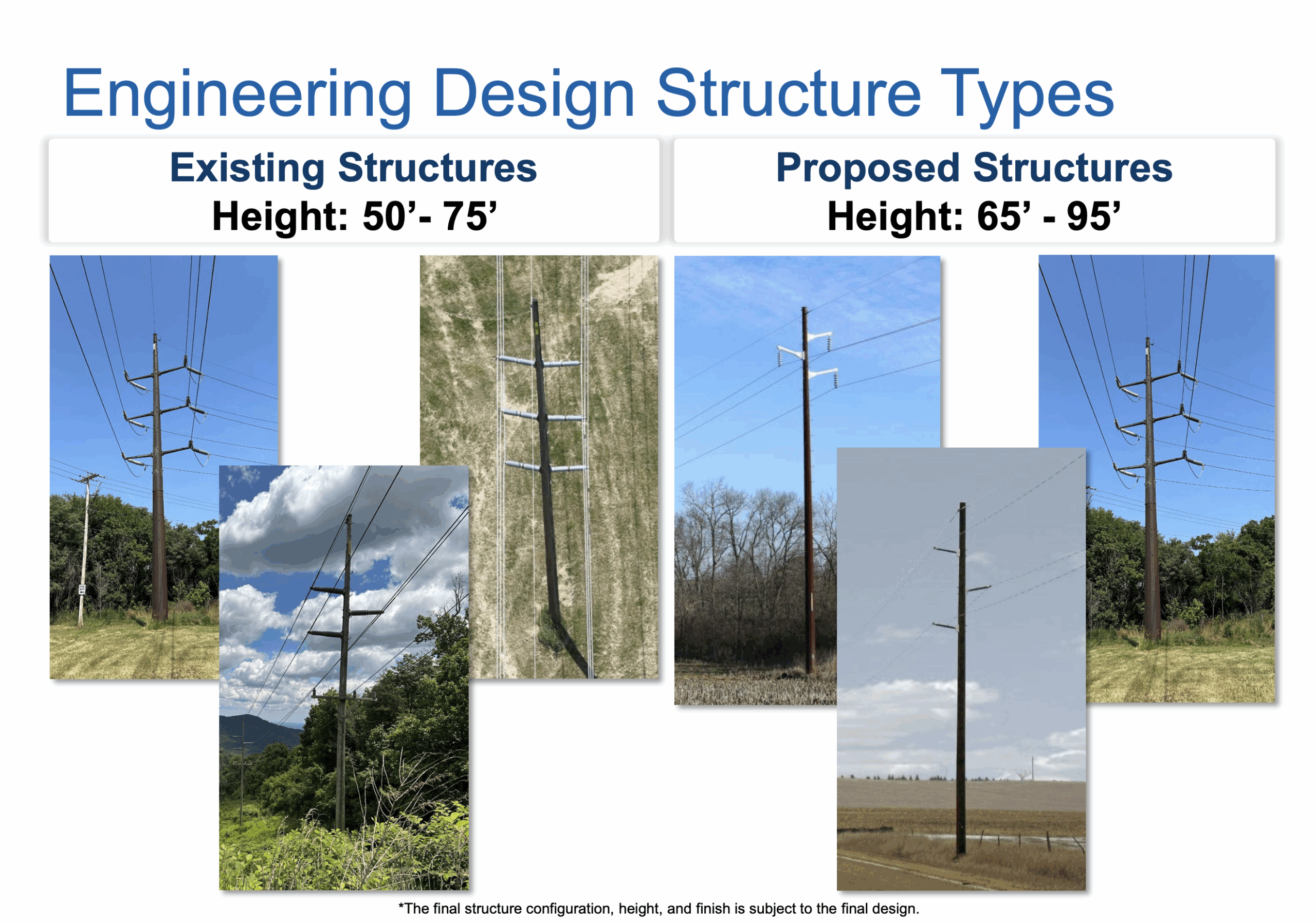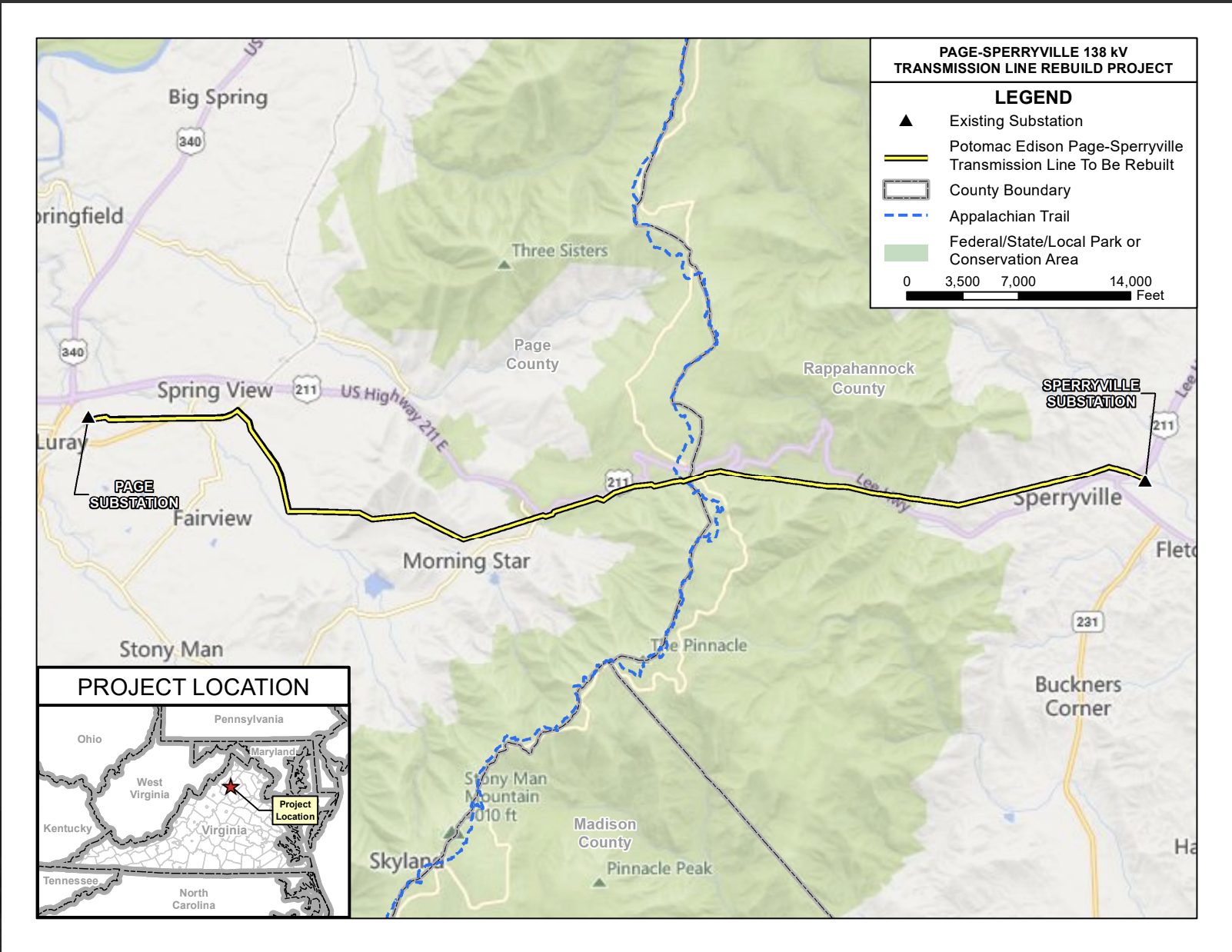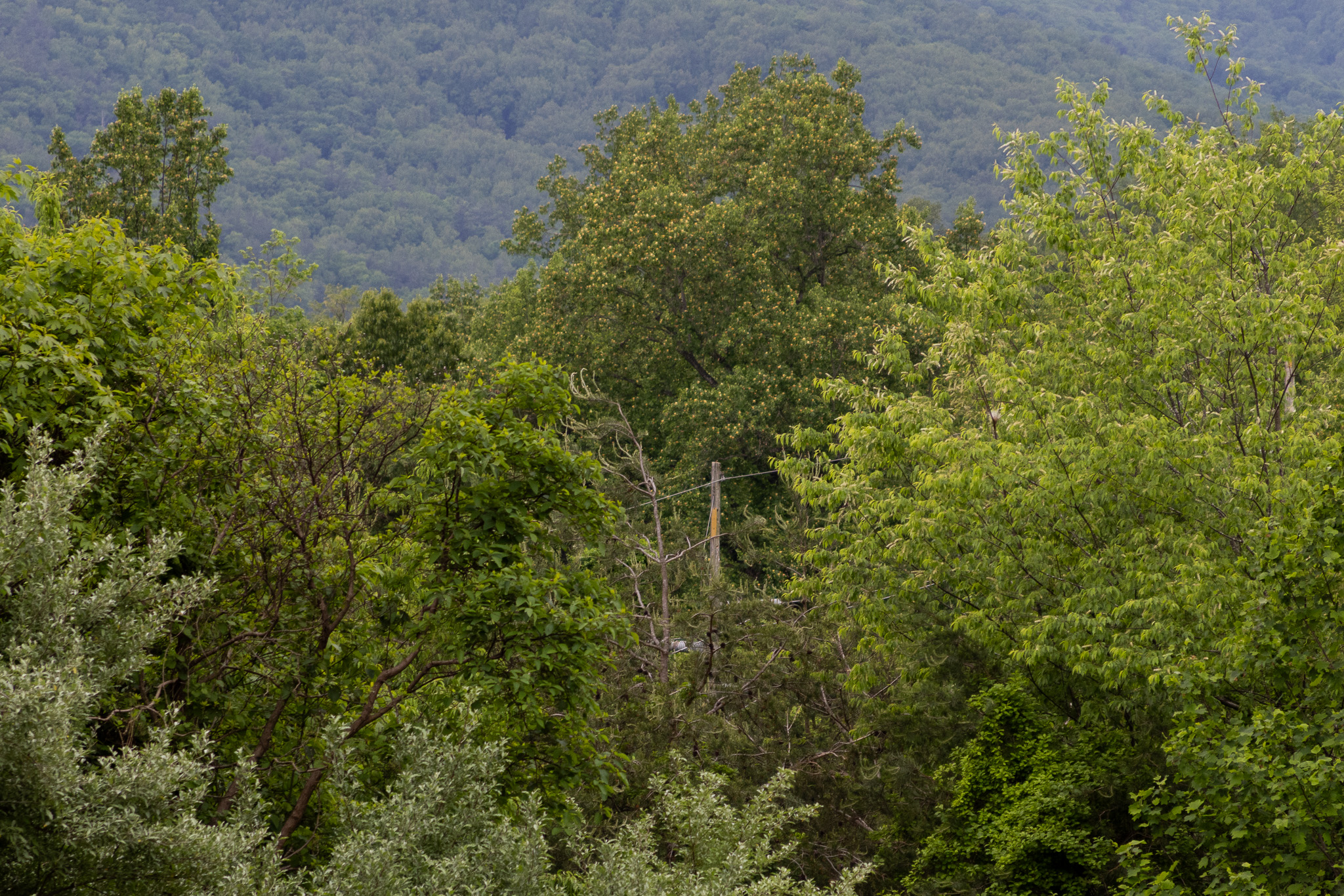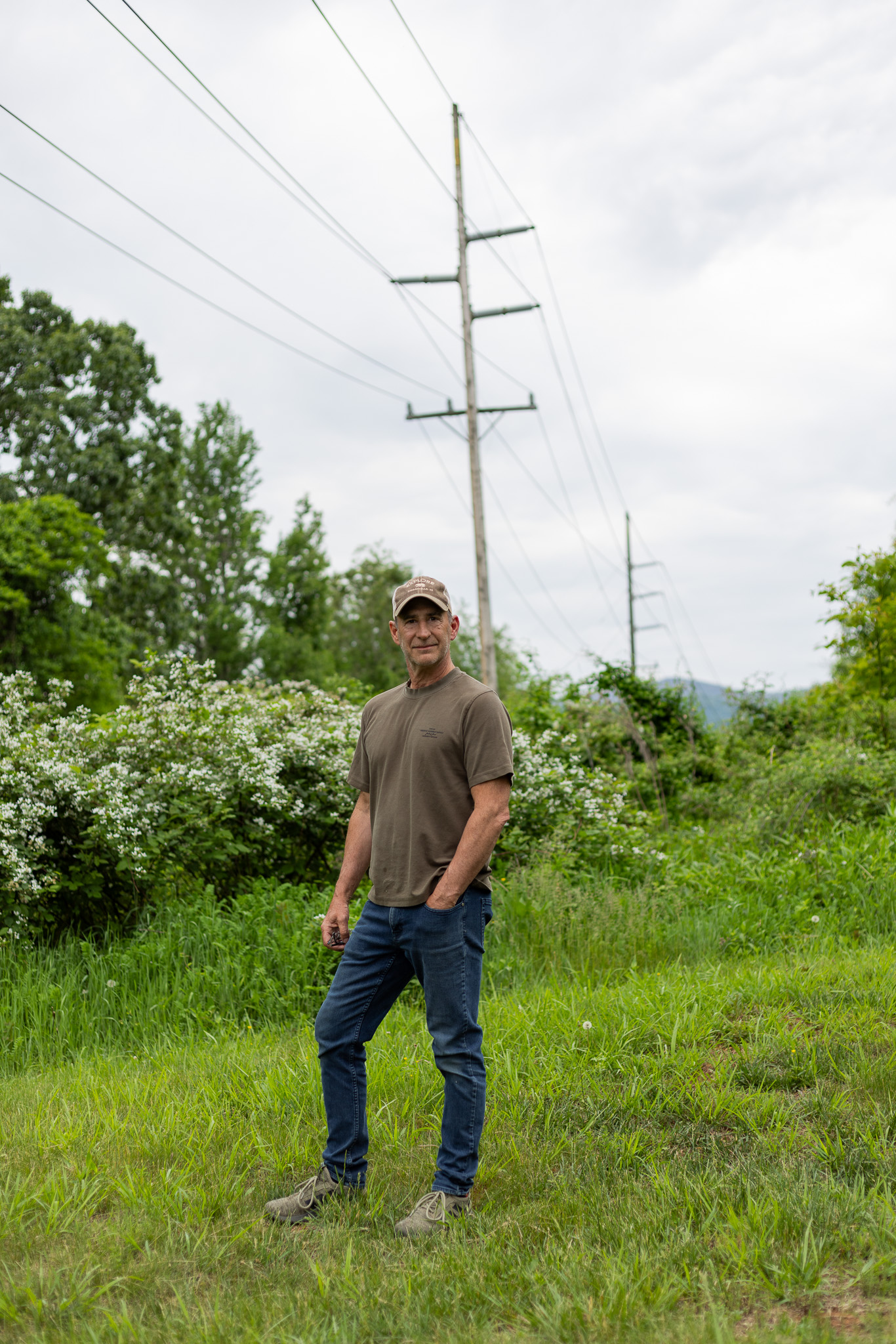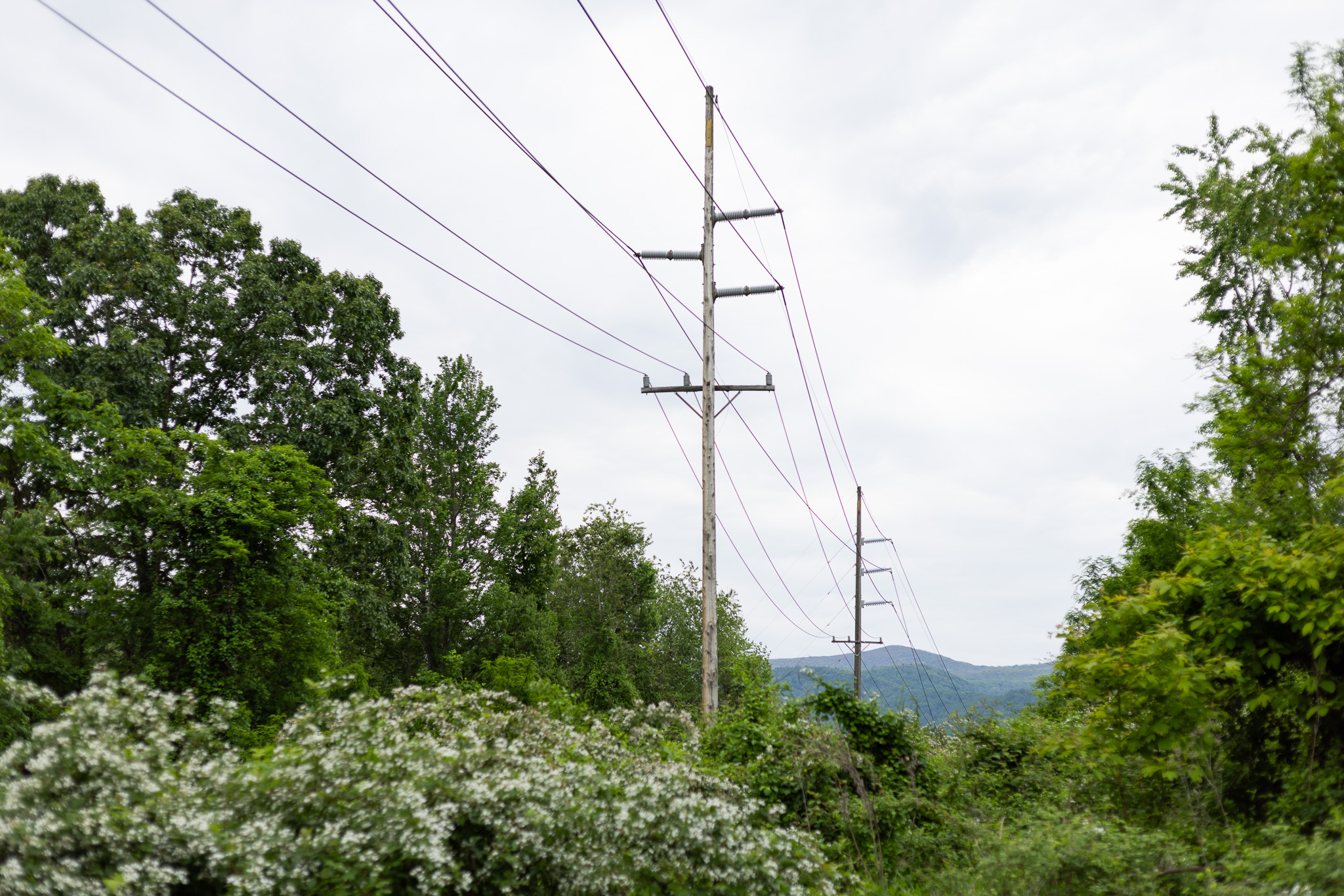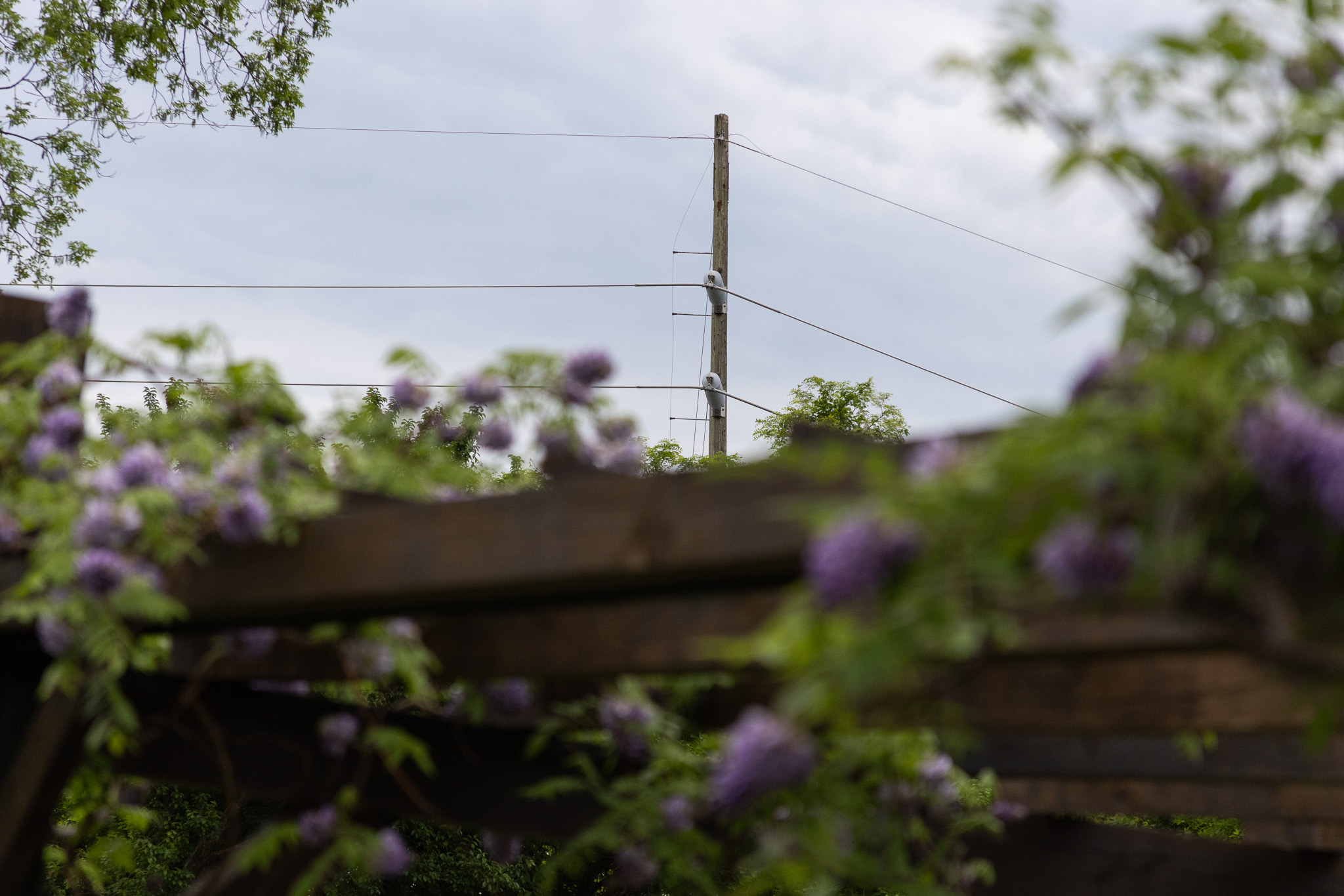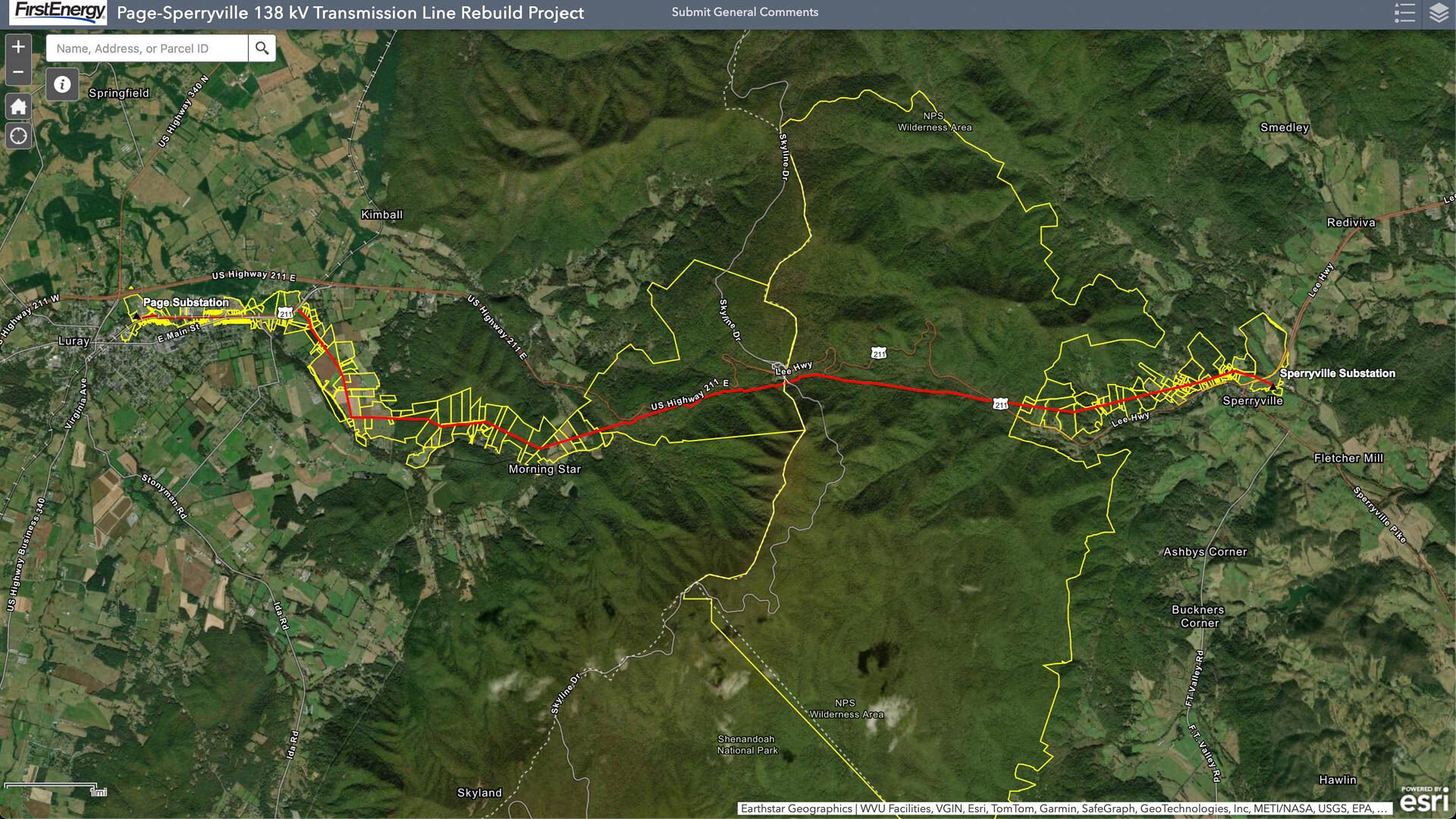Company contends it’s routine; others fear energy demands from data centers
When Kerry Sutten steps outside his Sperryville home, he is greeted by a beautiful view of the Blue Ridge Mountains. There are power lines and poles mixed in with the trees, but they’re barely noticeable, especially in the lush summer foliage.
“Now imagine 20 more feet above the trees,” Sutten said.
Potomac Edison, an electric utility company, is planning to replace a 13.8-mile stretch of power lines and poles from Luray in Page County, over the Shenandoah National Park through Sperryville to a substation on River Lane. The new transmission line and taller poles will run right through Sutten’s yard.
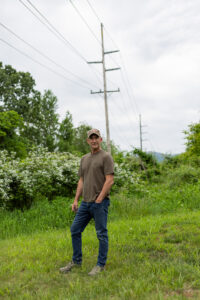
Kerry Sutten, owner of Before & After Cafe in Sperryville, stands next to his driveway where the Page-Sperryville power transmission line runs through his property. (Photo/Ireland Hayes)
Both Sutten and environmental advocacy groups are worried that these upgrades are not just routine maintenance, but a first step toward feeding more power to data centers in Northern Virginia — a prospect that has people on edge about their viewsheds, even if no data center is ever built on Rappahannock soil.
“I would inherently argue the fact that this system upgrade is at least not to some capacity being driven by data centers,” said Kyle Hart, the mid-atlantic program manager for the National Parks Conservation Association, a Washington, D.C.-based group devoted to protecting national parks.
But representatives from Potomac Edison and its parent company FirstEnergy have been adamant throughout preliminary project discussions that the upgrades are vital to power access in Rappahannock, and that taller, sturdier steel poles are the logical replacement for existing wooden ones. The transmission line transfers most of the power to Rappahannock County, which is then distributed by Rappahannock Electric Cooperative.
“If we don’t move forward, we run the risk of unplanned, potentially lengthy outages in the future due to equipment failure or severe weather that would impact thousands of area residents,” Will Boye, a senior communication representative for FirstEnergy, wrote in an email.
Project goals
According to the Page-Sperryville Transmission Line Rebuild Project website, the goal of the rebuild is to replace 13.8 miles of aging power lines and poles, which according to the company, will “maintain line reliability for customers in the area.”
Boye said the upgrade plan does not include increasing electrical voltage capacity, currently 138 kilovolts, which is standard voltage for a transmission line of its size. The website does, however, list increasing the capacity of the line “with upgrades at the existing substation” as a benefit of the project.
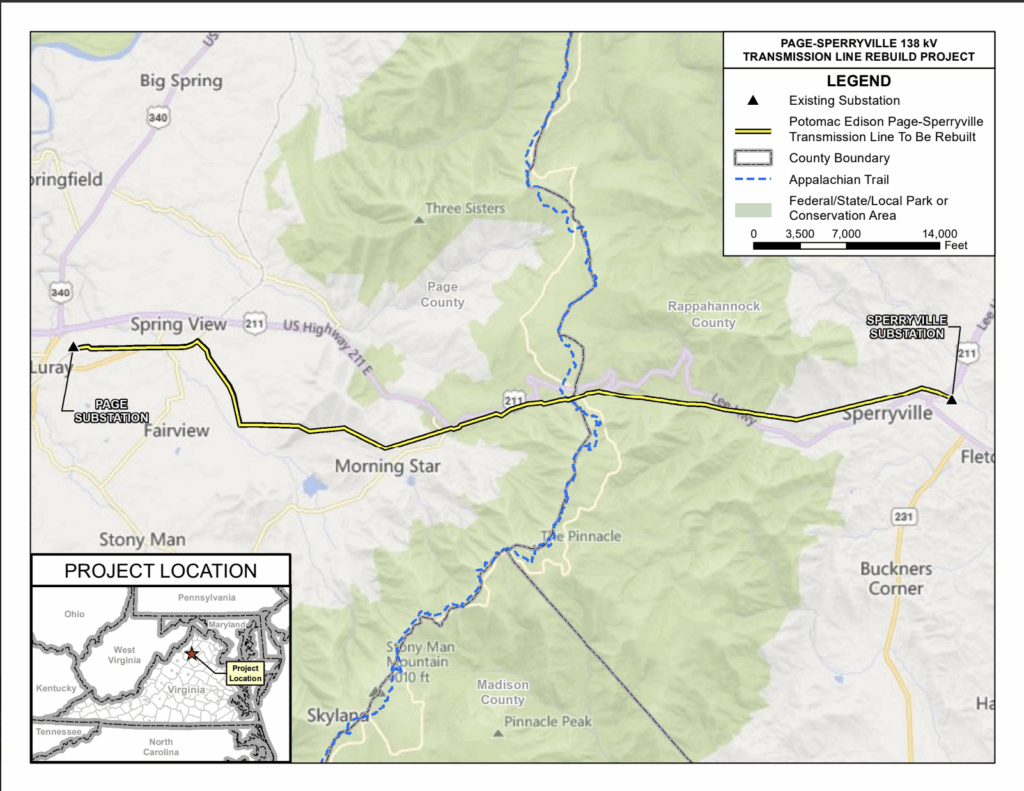
Map of the path of the transmission line. (Courtesy/FirstEnergy)
Boye said the proposed steel monopoles will range in height from 65-115 feet tall, with the existing double poles ranging from 55-95 feet, meaning in a worst case scenario, poles could grow by up to 60 feet in some areas.
The right of way in most places will not need to be widened, but between the Page County substation in Luray and the Shenandoah National Park, the right of way will need to be expanded by 15 feet.
“The project will primarily utilize the existing transmission right of way to minimize impacts to landowners, the environment and the community,” Boye said.
If all permits and applications are awarded by the State Corporation Commission in early 2026, Boye said construction will begin in late 2027. Boye said FirstEnergy also recently conducted cultural resource studies in Sperryville to “minimize the impact of our planned work” in the area, but the results of those studies are not public.
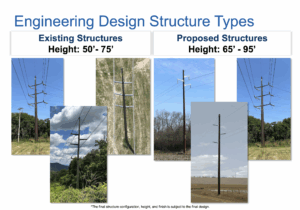
(Courtesy/FirstEnergy)
Value of viewshed
Sutten, owner of Before & After Cafe, said he has been in negotiations with FirstEnergy for several months and has “very specific restrictions” he is requesting for the approximately 600-foot portion of the line that crosses his property.
He said he has been working with FirstEnergy’s right of way consultant on an agreement regarding lower pole height and materials. During these negotiations, he was told the team wants the line to be more level, with taller poles in valleys and gullies instead of dipping up and down across the mountain range.
“We have to think about what the implications are for our viewshed, not only personally for me, because it’s my front yard, but what does it mean when you’re in Sperryville or Turkey Mountain or Red Oak, and you’re looking back, or at the park, and you see these towers sticking up,” he said.
Sutten, who worked as a congressional and executive branch staffer in Washington, D.C., said he thinks FirstEnergy is planning for future growth and increased power fueled by the data center boom. While the company won’t admit it publicly, he said, its push for taller, sturdier metal towers suggests it’s positioning itself for long-term expansion — a move he worries will come at the expense of the county’s scenic views.
“I spent 30 years in policy. If I were that company, I would plan for the future, and the future is more power transmission. So despite the fact that they won’t say it, I think it is unequivocally what they’re doing — they’re preparing for their future growth,” Sutten said. “But does that need to be on the backs of this amazing viewshed that we have here?”

A power line peaking out over the top of Sutten’s pergola in his front yard. (Photo/Ireland Hayes)
Local attorney David Konick is representing several Sperryville residents whose land and views could be affected by the upgrade’s larger poles.
Konick said in 1983, when the existing poles were installed, he worked on contracts for landowners that placed a restriction on the height of the poles and limited the size of the right of way. He said those agreements had no expiration and hold true today. But he said those without existing contracts may be signing more rights away than they realize.
Sutten echoed Konick’s concerns: “Some people may just say, ‘Sure, go do what you want,’ and just kind of sign away their rights for the next eternity, because that’s what this is, right? Once you sign it, it’s gone.”
‘A Band-Aid on a bullet wound’
Hart said he has no doubt that the upgrades are happening to prepare for more power to be funneled over the mountains to Northern Virginia to feed the growing data center giant.
“Virginia has permitted more data center capacity than exists elsewhere in the globe. We’re the national leader. We’re the global leader in the data center space in Northern Virginia,” he said. “That has placed immense strain on the existing grid … and it’s not a secret that … all of these power entities across various state lines are scrambling to keep up.”
Hart said projects like this one are “essentially a Band-Aid on a bullet wound.” He said while yes, the 40-year old poles and infrastructure do need to be replaced, “what’s being talked about is not an upgrade to the existing system that comes through that corridor to keep it operational — it’s major upgrades,” he said.
“Looking at Shenandoah, the question becomes — what happens when either some of these projects don’t get built because of community opposition, all of these projects get built and it doesn’t satiate the energy demand at the data center industry,” Hart added. “In five years, they’re going to say, ‘Well, we still have growing energy demands, now we need a second power line or now we need a 500 kilovolt line.”
Chris Miller, president of the Piedmont Environmental Council (PEC), said the nonprofit environmental organization does not have reason to distrust what FirstEnergy is saying about the necessity of the current project. But he cautions that doesn’t mean the corridor will not be expanded in the future.
“[The power industry is] looking for places to put these massive amounts of energy,” Miller said. “They’re looking for corridors where they can move it through. And so from the perspective of PEC, we’re looking at existing transmission routes as places where the industry will try to do an expansion … there are not that many crossings of the Appalachian Trail and the Shenandoah National Park.”
Miller said PEC is monitoring existing transmission routes and smaller transmission lines that have the potential to be major energy corridors. The organization is hiring a full-time employee to monitor transmission planning, which it sees as the “single largest threat to the whole Piedmont region.
“And all you have to do is go look at what’s happened to Loudoun County to see what happens when you go from light transmission to 230 or 500 kilovolts. You go from essentially a wooden pole that you don’t notice to a 200-foot tower,” Miller said.
Hart points to a transmission line near the Swift Run entrance to the park in Elkton, where multiple monstrous towers can be seen from Skyline Drive, as a worst-case scenario.
“Most people are able to drive under the lines at Thornton Gap and not even realize that they’re there,” he said. “What exists north of the Swift Run entrance to the park is like, that’s an industrial landscape … our fear is that every single power line corridor in [SNP] is eventually going to look like that if nothing changes.”
Community input
FirstEnergy hosted a community outreach meeting in November in Luray, but Sutten said he felt like the meeting was not well advertised or well attended by Rappahannock residents.
He has been reaching out to FirstEnergy and local government officials lobbying for another community meeting, this time in Rappahannock.
Boye said the company is not planning to host another outreach meeting, but he encourages residents to visit the project website at rappnews.link/qra or reach out to the company’s hotline at 888-311-4737 or [email protected] for more information and to voice their concerns.
Click here for an interactive map for residents and property owners to leave comments.
